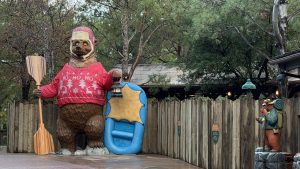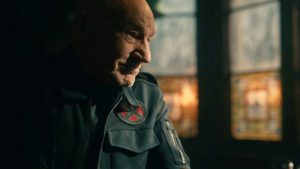UNDER a high, hot September sky, Disney Studios has clearly surrendered. Deep in the heart of the back lot, all those striding, BlackBerry-monitoring employees give way to denizens of a different sort. Pirates of every hue, hair configuration and state of personal hygiene. Pirates in velvet, silk and leather. Chinese pirates and African pirates, French pirates and Arab pirates, 150 of them all told, some rock star, some scurvy dog.
They are gathered for a rare meeting of the Brethren Court at dark and dangerous, and geographically indeterminate, Shipwreck Cove.
If, on this scandalously fine autumn day, these particular pirates appear to be milling rather than marauding — lounging about outside Soundstage 2, eating lunch, talking on cellphones — it is just an illusion, a rip between worlds. Reality lies within. Step inside.
Many movie sets are, to an outsider, disappointing. The cameras, cables and other equipment easily dwarf a house or an apartment, even a hotel, leaving only the smallest nest of space in which the actors must perform. A castle high atop a hill can turn out to be cleverly painted scrims in front of a blue screen, the exteriors shot from teeny-tiny models.
But no one would call the Shipwreck Cove set from "Pirates of the Caribbean: At World's End," opening May 25, disappointing. Which is a very good thing. The third installment in the wildly successful Johnny Depp franchise, "World's End," is, to put it mildly, highly anticipated. The first two have grossed almost $800 million domestically — not bad for a narrative arc based on a theme park ride. Inside a cavernous soundstage (previously flooded and used for the treasure cave and bayou scenes in the first two "Pirates" films), amid steam and smoke and flame, there are, of course, a forest of cameras and monitors, cables and sound equipment and lights, not to mention all the people who work them. But they are barely noticeable next to the ships.
There are ships for every sort of pirate, the prows of which cut through the darkness, bedecked with women and dragons, with gilt and barnacles. There are half a dozen full-scale partial models, behind which runs a 300-foot hand-painted background scrim depicting more ships in various sizes and perspectives. In the middle of it all is a great and splendid wreck, the meeting place of the pirate lords and home to Capt. Teague Sparrow, keeper of the Pirates Code, who clearly shares some sort of bloodline — and certainly a stylist — with Depp's Capt. Jack Sparrow.
Teague, of course, is played by Keith Richards, who left the building only the previous day. In his stead is a very likely photographic stand-in, all flapping hair and hands and lurching entrances.
Also on deck are Depp, Keira Knightley, Orlando Bloom and Geoffrey Rush, reprising their roles from the previous films, as well as an alarming assortment of multicultural pirate lords (including a new character played by Chow Yun-Fat) as they seek, in this installment, to rescue Cap'n Jack, who has been eaten — but apparently not digested — by the monstrous Kraken.
In the light of 500 flickering candles, they discuss pirate matters and make accusations and threatening proclamations, while beneath them floorboards creak, around them costumes rustle and clank, and above them rigging exudes a distinctly tarry odor.
Outside the ring of filming, crew members wander by, some with Cap'n Jack pirate locks, a few with "Livin' the ride" T-shirts. An assistant director warns everyone to move away from the metal tubes that stand here and there around the ship. "In a few minutes, those are going to burst into flame," he says.
"We really need a cone or something here," says one crew member as one person after another, apparently not hearing the bit about fire, brushes closely past the tubes. "I'll stand here. I'll be the cone."
BIG ON THE SMALL STUFF
IT is a whole other world, mere minutes away from beautiful downtown Burbank, a parallel universe conjured out of wood and foam and paint, where meticulous detail — real cannons bouncing on real wood, real velvet shredded and burned to look ancient — anchor the fantasy and make it real.
That willingness to sweat the small stuff paid off. "We had no idea how well No. 2 was going to do," says production designer Rich Heinrichs with a laugh. "If we'd known, we wouldn't have worried quite so much about the budget for 3."
Not that anything was done on the cheap. Director Gore Verbinski never wanted a blue screen extravaganza — he wanted real pirates, real ships, real tempestuous seas (which he got during a famously difficult shoot in the actual Caribbean).
"He has a lot more environmental approach to sets," says Heinrichs, who worked on the last two films of the trilogy. "We were always creating a world beyond the camera because we want people to believe that there is another world out there.
"It is unusual to do so much," he adds. "My hat's off to Gore for wanting to go this far. With fantastical things, you have to be grounded in reality."
"I've done some big movies in the past," says Chow, who plays a pirate lord, "but walking onto the 'Pirates' set was like walking into a ride at Disneyland. Everything was built with so much detail. The steam baths had real working steam, and the old fishing village came complete with a market, huts, bridges and even boats that moved through the set they filled with water."
This is only one of a series of sets that have consumed the lives of the "Pirates" team for years. Universal Studios Stage 12 recently housed Singapore, complete with ocean and a town with 11 full interiors, while in Palmdale three full-scale ships on gimbals tossed and turned in a warehouse that once sheltered the Space Shuttle.
THE FANTASY'S REALITY
ORLANDO BLOOM, with two fantasy epics under his sword belt now (his first being "The Lord of the Rings" trilogy), found life on the lavish set exhilarating and exhausting.
"It gives you a frame of reference," he says. "Puts you in a situation, which is especially important in an action adventure where you might be waiting around for a shot to be set up and then you have to suddenly be very intense and in the moment. Atmosphere is very important. The blue screen is much more … challenging."
But physically detailed sets have their drawbacks too; weeks in cavernous gloom or on rain-lashed decks can leave one grateful for things like sunshine and automobiles.
"It's incredibly hard work," Bloom says. "In Palmdale, it was raining all the time. We all got sick once or twice. It was brutal. I've spent five years of my life on this, most of my adult life, and it's quite nice to return to the modern world."
In Shipwreck Cove, however, conditions are, with the exception of the tubes of fire, ideal.
"The lighting's always tricky for these period films," says Heinrichs. "You don't want it to look fake, but you have to see."
His answer here was to have set decorator Cheryl Carasik make 3,000 candles, most with double or triple wicks. The anchor-shaped chandelier Verbinski wanted (the size of a real anchor) required 60 candles alone with removable wax drips — Verbinski wanted long drips in certain scenes but not in close-ups, so Carasik had two on-set dressers torching candles pretty much continuously, just to get the proper drips.
"And you had to be careful," she says with a laugh, "because the fire department is picky, and the set was made of foam."
Carasik, who worked with Heinrichs on the previous "Pirates," reveled in the creation of a whole other world, finding period bottles from companies catering to Civil War re-creations and creating more than 700 barrels without the modern strapping. The huge carved table around which the pirates gather in Shipwreck Cove is a work of art. Literally. The centerpiece of the scenes shot there, it was made by the Disney prop department. "They said, 'We can do it, but it's going to cost you,' " says Carasik. "And it did." Between $30,000 and $35,000, she estimates.
The huge painted scrim too was a decision based on the marriage between fantasy and reality the film requires. Most cinematographers aren't huge fans of scrims because usually they can be lighted only from the front, Heinrichs says. But for this movie, he chose a painting over a blue screen because it creates a Maxfield Parrish-like reality. "More picture than photograph," he says. "And this one we can back light in certain places."
Some early sets were pulled apart and used, in some form, several times — the rum locker of the Black Pearl became the brig of the Flying Dutchman, and the floorboards of Shipwreck Cove came from the Singapore set.
Many of the sets remain, in one form or another — while the Shipwreck Cove sequence was shooting, Disney officials were giving tours of a Black Pearl set housed nearby to corporate partners. Pieces of some will be used at the various premieres and the rest is in the warehouse, ready to go should there be another "Pirates" movie.
"It was such an amazing experience," says Carasik. "I have no idea what I'm going to do next. What do you do, really, after you've done 'Pirates of the Caribbean'?"





